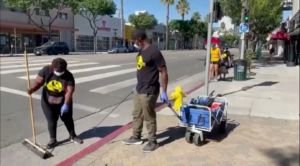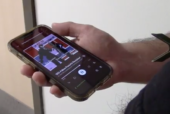On May 31, 2020, six days after George Floyd’s death, Latora Green began a protest in front of a shopping mall in Sherman Oaks.
Every day since, Green says she has returned to that same spot to hold a pro-Black Lives Matter demonstration.
Sometimes Green is the only person sitting in on the protest on a given day. On other days, up to 100 fellow demonstrators will join her.
Green has transformed her long-running Black Lives Matter protest into a grass roots organization called The Valley of Change.
As time passed after Floyd’s death, and crowd sizes of larger Black Lives Matter protests in Los Angeles began to diminish Dani Marzouca found Green’s organization through Instagram that was continuing demonstrations. This is when Marzouca met Green. She’s now a regular volunteer with The Valley of Change, which holds monthly community trash cleanups, organizes food donations and gives away school supplies.
“That time period,” Marzouca remembered, “there was just a lot of death in the news and it’s the most natural thing to be angry and express that and being with other people who feel the same way who are willing to fight to create a new world where this doesn’t happen.”

Latora Green, leader of The Valley of Change, directs a volunteer during a community trash cleanup.
The Valley of Change is one small manifestation of the broader Black Lives Matter movement, which The New York Times in 2020 proclaimed, “May be the largest movement in U.S. history.”
The larger Black Lives Matter Movement started in 2013 when George Zimmerman was acquitted for the death of Trayvon Martin. Leading up to 2021 the organization has sprouted chapters all over the United States and evolved in several ways outside of organizing protests that have made international news.
The Black Lives Matter Los Angeles Chapter is involved with various projects outside of demonstrations, such as creating and inspiring youth leaders, engaging in local and statewide policy initiatives, hosting “know your rights” training sessions for members and allies. The BLMLA Research Team engages in data support for campaigns
Along Ventura Boulevard, volunteers with Green’s The Valley of Change organization will walk the streets sweeping and picking up debris or trash — which Latora calls, “treasures.” The Valley of Change volunteers also hand out water and other supplies to any unhoused neighbor they encounter.
“Building up the community — this is an act of justice,” Green tells volunteers during a recent cleanup, “and we need to take care of our environment.”
Latora Green works with several area high schools and invites students to assist with the monthly cleanups and food donations. She even asks students to assist with research about wastes, plastics and cigarette buttes.
Dani Marzouca sees the future and past of activism, “We see the people creating change, and calling on all the activist before us, ancestors, and people who have shed blood for this movement and believe that together all of that energy will end policing.”
Historian and archivist Keith Rice, who works for the Tom & Ethel Bradley Center at CSUN’s University Library, refers to himself as an “academic activist.” He has documented the protests that started in 2020, and says this act of preservation is a necessity.
Keith Rice says he has also photographed Latora Green’s demonstrations on Ventura Boulevard.
“You can change things on a systematic level,” Rice said, “but you have to change the hearts, the minds, the people.”
As an archivist, Keith Rice oversees a collection that includes historic images of 1960s civil rights movement figures including Malcolm X and Martin Luther King, Jr., along with images of events like the 1965 Watts Rebellion.
In those black and white photographs, he sees links to the present-day movement.
“Once I started going and photographing the protests,” Rice said, “and understanding what they stood for, I am a defender of them [Black Lives Matter].”
Decades later, “we see young children bringing their signs every single day as they drive by,” Dani Marzouca says, “putting their fists up, screaming Black Lives Matter.”
This show was produced by Domonique Isabeau, Jessica Harper and Cesia Lopez.

 Tweet this Video
Tweet this Video Share on Facebook
Share on Facebook Share via E-mail
Share via E-mail

